








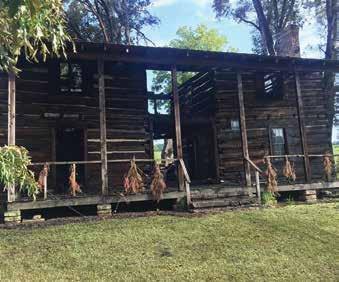

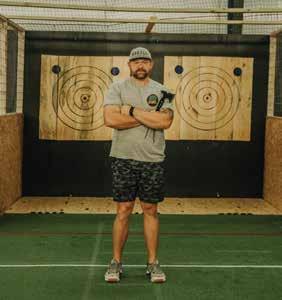





Carol Pappas is editor and publisher of Discover St. Clair Magazine. A retired newspaper executive, she served as editor and publisher of several newspapers and magazines during her career. She won dozens of writing awards and was named Distinguished Alabama Community Journalist at Auburn University. She serves as president/CEO of Partners by Design, which publishes Discover and LakeLife 24/7 Magazine®.
Roxann Edsall is a freelance writer and former managing editor of Convene Magazine, a con vention industry publication. She has a degree in (broadcast) journalism from the University of Southern Mississippi, worked as a television news reporter in Biloxi and as a reporter and assignments editor in Birmingham.
Meghan Frondorf
Meghan Frondorf is a professional photogra pher. She has been doing photography for 12 years locally & across the country. She enjoys doing nature/freelance and lifestyle photogra phy.




Robert Debter was raised on his family’s Her eford farm in Blount County and previously served as vice president of the Blount County Historical Society. He has been the archive director of the Ashville Museum & Archives since May 2016 and traces three branches of his ancestry to St. Clair County in 1820.


Richard is a full-time professional photogra pher based in the Springville area and owner of Natural Light Photography LLC. His 50+ years of experience behind the lens of a camera includes working as a photojournalist for a global technology company. His credentials include many magazine cover shots, standing as a Canon Image Connect Photographer, and member of the Little River Arts Council.

Graham Hadley is the managing editor and designer for Discover The Essence of St. Clair Magazine and also manages the magazine website. Along with Carol Pappas, he left The Daily Home as managing editor to become vice president of the Creative Division of Partners by Design multimedia company.
Elaine Hobson Miller is a freelance writer with a B.A. in journalism from Samford University. She was the first female to cover Birmingham City Hall for the Birmingham Post-Herald, where she worked as reporter, food editor and features writer. She is a former editor of Birmingham Home & Garden magazine and staff writer for Birmingham magazine.
Paul South, a native of Fairfield, is an Auburn graduate with a degree in journalism and a double minor in history. He also has a Juris Doctorate degree from the Birmingham School of Law. Although sports writing was always his first love, he had a versatile career as reporter, columnist and first full-time sports information director at Samford University.
Scottie Vickery is a writer with a degree in journalism from the University of Alabama and was a reporter for The Birmingham News Her first assignment was covering St. Clair and Blount counties. She has more than 30 years of writing and editing experience and her work has appeared in a variety of publications. She also has worked in the nonprofit industry.
Loyd McIntosh is a freelance writer and mar keting professional originally from Trussville. He has contributed to more than 30 online and print publications. Loyd is also a former re porter and sports writer for several newspapers throughout the Southeast, including The Daily Home, and was the managing editor for The Cahaba Times and Upper90 Magazine
Mackenzie Free is an experienced and nation ally published photographer with a bachelor of fine arts degree. She is a Birmingham native now cultivating life on a farm in Steele with her husband and four daughters.

Ours is the perfect job. Find a good story and tell it. Find a good photographer and illustrate it. And that’s what we’ve been doing for 11 years now. Our magazine was founded on the principle that there’s a story to tell around every corner, around every bend in the road. You just have to discover it … and tell it.
As I edit this edition of our magazine, I can’t help but think about the common threads that weave them together. It’s much like the deft handiwork of Ashville’s Tracey Rybka, who stitches memories and treasures together in a patchwork of T-shirts and fabric scraps that transform into a quilt that comforts both body and mind.
It’s like the skillful hands of Odenville’s Trudy Mayoros, who knits prostheses for breast cancer patients around the country – soft and comforting in a time of great emotion and need.
For these stories always point back to needs – seeing them and caring enough to fill them.
The Looney House, long a St. Clair County historic landmark near Greensport, fell victim to fire in August. Its story is much the same. In 1972, the St. Clair Historical Society envisioned a need to restore one of the oldest structures in our state to serve as a museum for generations yet to come. Now, a new generation is being called upon to restore it from the ashes of tragedy.
When Michelle Tumlin lost her veteran son, Houston Lee, to suicide, her grief led her family to create the Houston Project in downtown Pell City. It is a patriotic clothing store, where every penny from every sale goes to help other families of veterans cope with a return to everyday life.
As we approach Veterans Day, our thoughts naturally turn to veteran issues. And we look to the Robert L. Howard State Veterans Home with pride in celebrating its 10th anniversary in St. Clair County. It has served not only as a state-of-the-art, real-life ‘home’ for those who valiantly served our country, it
is a model other communities strive to emulate.
Then there’s recreation – from hiking to kayaking to axe throwing? Yes, axe throwing. St. Clair seems to find a way to fit any need. We’ll take you on treks across the county, around our lakes and up our mountains, giving you an outdoor preview of the trails that await your next outdoor adventure.

And, yes, we’ll take you inside the axe throwing center that’s right on target with this growing sport.
Perhaps one of the most sizable needs of our county over the years has been retail. Enter developer Bill Ellison and later Noon Real Estate, and a vacant hospital site fronting I-20 in Pell City is about to become a retail mecca known as Pell City Square. National names like T.J. Maxx and Hobby Lobby are coming to the city along with a number of other well-known retailers. It is setting the stage for growth like never before.
That’s what is in store in this edition of Discover. Turn the page and discover it all with us!
Carol Pappas Editor and Publisher
Jacket made from ‘scrappy quilt’ with pieces that would have ended up in landfill

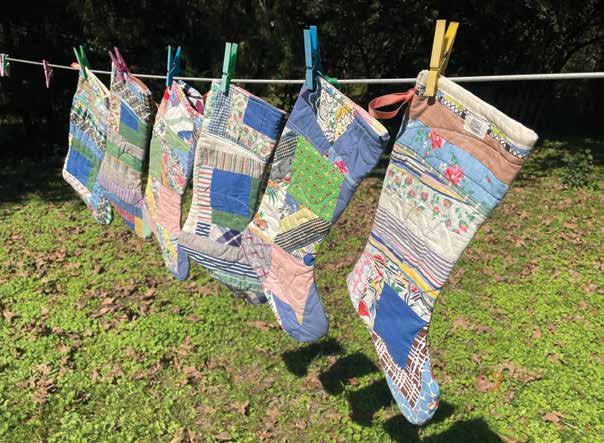 Story by Elaine Hobson Miller Photos by Richard Rybka
Story by Elaine Hobson Miller Photos by Richard Rybka
You might call Tracey Rybka a “memory preservationist.” She turns old shirts, used quilts, scruffy housecoats and fabric scraps into quilts that preserve memories of the people who wore or used those original items. She calls them T-shirt and memory quilts. Her customers call them wonderful.
“My dad always wore overalls,” says Vicki Buckner of Springville, a happy Tracey’s Stitches & Designs client. “When he passed away in 2020, I took his overalls to Tracey, and she made miniature overalls for 20 teddy bears. I gave those bears to my nieces and nephews – his grandchildren – for Christmas that year, and they loved them. All of them are in their 20s and 30s, and they say they bring back lots of memories of their grandfather. Tracey did a wonderful job.”
Tracey has been sewing since she was a child. Her first project was a skirt for 4-H
Customer’s antique handmade quilt repurposed as Christmas stockings

Club, and her first quilt was for her own granddaughter. “My mother sewed and quilted, and she has quilts all over the world,” Tracey says. “Almost 10 years ago, my daughter went through some fertility issues. After five years, she and her husband gave up, then she got pregnant. I wanted to do something special to honor my mom and my new granddaughter, so I made a baby quilt. I was hooked.”
Between them, she and her husband, Richard, have five children, seven grandchildren and one greatgrandchild. Tracey has made quilts for all but a couple of those descendants. “I watched YouTube and read quilt magazines,” she says. “I still do. I probably have 50 magazines.” She keeps several projects going at the same time and estimates she has made 50-60 quilts in the past 10 years. “The majority have been memory quilts and T-shirt quilts,” she says.
Her sewing room in her Springville home contains boxes of fleece, rolls and bags of batting, plastic see-through bins of zippers, threads and fabric scraps. Three clothes racks are draped with WIPs (works in progress), including quilts and some finished Christmas stockings. Several fabric animals watch from atop the bins, awaiting their final touches. She makes dogs, bears and bunnies from the same basic pattern, changing the length of their ears for the various species.
Often doing her hand work in a chair draped with the first adult quilt she made, she has a 10-foot long-arm machine nearby for the quilting process. Originally, she quilted on her mother’s long-arm, a 1950 Singer A1 built for use in a sweatshop. “I used it my first four to five years, but it got hard to find parts for it,” she says. “So, I bought another used one.” She in fact has two working long-arms – her mom’s being disassembled and packed away.
She works from home Mondays and Tuesdays from 8 a.m. until 8 p.m., teaches sewing classes for all ages on Wednesdays at Sewing Machine Mart in Springville, then heads to Mentone with Richard, a photographer. They stay through Sundays, working from her shop from 8 a.m. until 5 p.m. Tracey opened the shop Aug. 1 and teaches classes there on Saturdays. She and Richard hope to buy land and move to Mentone someday. For now, they have a camper on leased land.
“We fell in love with Mentone 20 years ago,” she says. “It has a touristy, creative atmosphere.” Her shop is in a 115-year-old school building, formerly Moon Lake Elementary School, that has been turned into Moon Lake Village. Rooms are rented to artisans such as Tracey. “We have the fourth-grade classroom,” she says.
In her Springville classes she has taught 9- and 10-yearold Girl Scouts from Trussville, and her eight-year-old granddaughter is getting private lessons at Tracey’s home. “Mine are one-day classes lasting two to five hours each, and the students walk away with a finished project, such as 2-by-2-foot scrappy quilts, pillow cases and zipper bags,” Tracey says. “I usually furnish them a kit with all the materials they’ll need.”
While she orders most of her fabric online because of quality issues, choices, and the ease of getting it – not to mention wholesale pricing – some of her best work has been from scraps. “I save everything,” she says. “I make scrappy-

fabric wall hangings from old sheets and pillowcases, stained shirts and torn jeans.”
An example of a “landscape quilt” hangs on a wall of her shop. Another WIP, it is a farm scene with a red truck, ducks, a barn and a house. She cuts wavy strips of fabric for the mountains in the background and the fields in the forefront. “I sold one last year with a swing made of fabric and jute that actually moved,” she says.
She encourages her students to use whatever materials they have on hand. “A quilt backing can be an old sheet, or you can make a quilt reversible with scraps on both sides,” she explains. “Then you just have to buy the batting. Actually, you don’t really need batting if the fabric is thick enough.” Although she pieces her quilts together on a sewing machine, she has no issues with those who prefer to do it by hand. “I’m not the quilting police,” she tells her students.
Dubbing her scrap-method “up-cycling,” she took a king-size quilt with holes and stains, cut all of that out, and made baby quilts, lap quilts, diaper bags and pillows. “That carried on the memories of that quilt,” she says. She has
The idea for The Yard at Angler’s Pointe was simple. Here in the South, some of our best memories happen“out in the yard” from family gatherings to everyday happy memories. The Yard at Angler’s Pointe is a gathering space for our community. From the stage for live performances, vendor space, and food trucks, The Yard is the perfect backdrop for great music, great food, and even better memories.

Early action takers get rewarded. We’re offering exclusive incentives for vendors who sign up now.


made jackets and vests from old quilts, too. “So, you don’t have enough tees or whatever to make a quilt? Add fabric,” she teaches.
Her T-shirt quilts are made primarily from kids’ tees and sports tees. The memory quilts are made from shirts, gowns and housecoats, overalls, blue jeans, baby clothes and just about any other type of clothing. “I’m working on T-shirt quilt now with a little boy’s leather vest in it,” she says. “The vest is a tiny thing. The boy is now in college, and his mom is having it done as a Christmas gift.”
She also makes cork wallets and purses. “I learned about cork on YouTube,” she says. “The cork is grown in Portugal, where cork oak trees are stripped, and the best bark is used for wine stoppers. The remainder is graded for other uses.”
According to an online article on cork fabric, the outer section of the tree bark is harvested with axes, not machines, then peeled back to reveal the cork layer. The cork is laid out to dry for six months, then boiled in water, flattened and molded into whatever material it’s going to be. “It’s pressed and then pressed again but with fabric the second time, to make cork fabric,” Tracey explains. Stripping the bark does not hurt the trees, and the bark grows back. It can be harvested every 9 to 12 years, causing no harm to the tree, so it’s eco-friendly.
“You can’t sew with cork on a domestic or household sewing machine, though,” Tracey says. “I use an industrialgrade machine. I buy patterns off YouTube. My breadand-butter is the T-shirt and memory quilts, but my fun is making purses and wallets.”

Denise Key believes she was one of the first people to hire Tracey to make memory quilts. Her husband’s parents had died, and hers were already passed away. While going through each parent’s belongings, she came across some old quilts made from clothes that were, in turn, made from flour sacks, and quilts made from old children’s dresses. “I had quilts made for our children and grandchildren,” Denise says.
There were some items too worn for Tracey to do anything large with, but she made them into small throws and pillows. “My nieces got a baby bag and all kinds of cool things from them,” Denise says. “Tracey probably made a dozen or so things for each side of my family. She would put a new backing on or whatever was needed to preserve it.”
Rhonda Reece commissioned Tracey to make six lap quilts and several pillows from her dad’s shirts. She gave those to her children and grandchildren, then had a tote made for her Bible, a hobo purse and doggy-doo bags to carry doggy bags when she walks her four-legged friend. “The doggy-doo bags are so cute,” Rhonda says. “She does wonderful work. And she’ll sit down and explain how she’s gonna make it or will custom make it the way you want it.”
It’s these kinds of comments and the emotions evoked by her work that give Tracey so much satisfaction.
“One of the first memory quilts I made was finishing one started by a woman whose dad had passed away,” she says. “It was made from his shirts. Her mom had dementia. The day the woman picked up the quilt, her mom was with her, and didn’t know who she was or where she was. But when her daughter put the quilt in her mom’s lap and asked, ‘Do you know what this is?’ the elderly woman looked at it and said, ‘I think this is your dad’s shirt.’ The daughter and I cried alligator tears.” l
Editor’s Note: You can find Tracey’s Facebook page at: www.facebook.com/TBRdesigns.

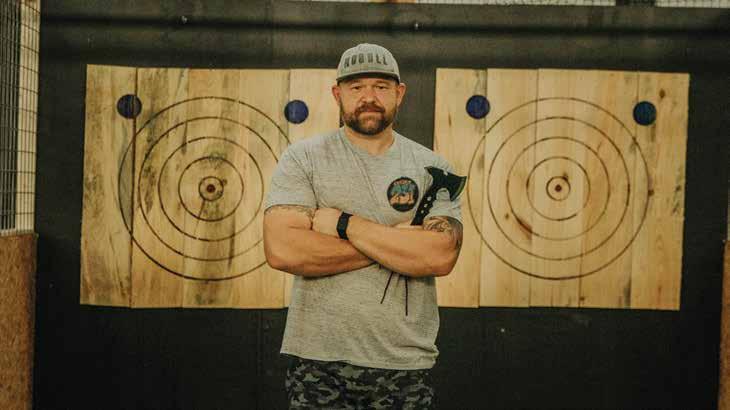 Story by Roxann Edsall Photos by Mackenzie Free
Story by Roxann Edsall Photos by Mackenzie Free
He sights his target at the end of the alley, some 12 feet away. Picking up the axe, he loosens his grip slightly to allow a perfectly timed release. Keeping his eye on the prize, he pulls the axe back, steps quickly forward and releases his throw. The resulting sound of axe blade meeting wood brings a smile to the thrower. This is the sport of axe throwing, and that thrower could be you.
Brand new to Pell City, Logan Martin Axe Throwing may be the new perfect date night activity for your next Saturday night. Or it may be a great option for your next birthday party or group event. They even offer discounts for groups of thirty or more.
Axe throwing is nothing new, but really gained recognition as a sport due to competitions involving logging camps. By the mid-1900s, logger sports were gaining in popularity as loggers looked for ways to entertain themselves while living in camps for months at a time.
Less than a century later, the urban version of the sport of axe throwing is becoming wildly popular around the world. There are even international leagues like the World Axe Throwing League and the International Axe Throwing Federation for competition level players.
“We’re not part of any league; it’s just for fun for groups, date nights and for families. The reason I wanted to open a place here is that my wife and friends and I had to drive to Trussville, Birmingham or Gadsden to enjoy the sport,” explains owner Zayne Ferguson. “Especially now, with the price of gas, it’s nice not to have to drive far. My brother and I always threw hatchets at trees growing up. It’s a lot of fun!”
His new venture shares the space with the CrossFit gym he opened in 2020. A competitive powerlifter for five years, he left his job at a local paint store to open a gym in a storefront on U.S. 231.
“Fitness is my passion,” he says, “especially CrossFit.” So, he got certified as a coach and called his business CrossFit231. He quickly outgrew that space and rented the current 8,000-square-foot warehouse building on Cogswell
my mother had the beginnings of dementia, she was in Birmingham, and I was in Pell City. Working full time, I couldn’t be there. But Always There could, and they helped her with the things she needed to remain independent -- taking her grocery shopping, making sure she got the right medications at the right time, being a companion. Always There allowed her to stay in her own home and took the worries away from my siblings and I when




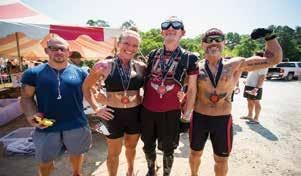








couldn’t

Avenue. He moved into the space in July and quickly realized he had room to start his own axe throwing business inside the gym.

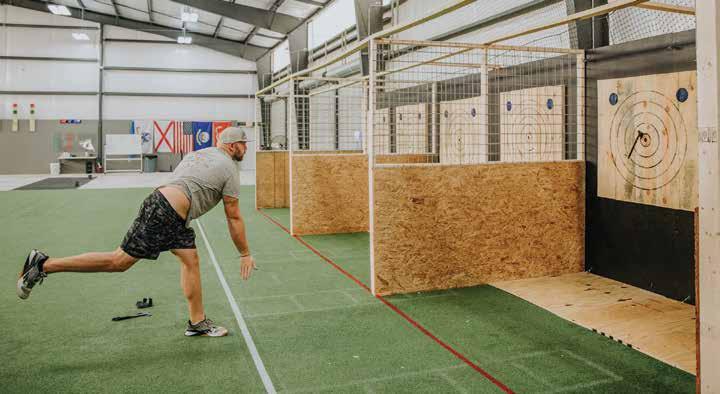
“I was at a birthday party at an axe throwing business in Birmingham. I did the math and calculated startup and operations costs,” Zayne explains. “Then I went to work making it happen.” He admits he probably works more now, but enjoys it much more.
Zayne grew up in St. Clair County, graduated from Pell City High School, played football for a Mississippi college, then returned to his hometown. He and his wife, Irish, enjoy living in the Pell City area.
His extended family has a sawmill in Cook Springs, which is a big help in getting the wood for the targets. They have to be replaced every week or two as the wood wears out from the repetitive strikes of the axe blades. He says using poplar or pine is best.
As expected, the targets have the usual rings and bullseye, but there’s also something perhaps unexpected to the new thrower. At the top of the targets are two blue dots. A strike between those two dots, referred to as “the clutch,” represents extra skill and comes with extra points.
The axes here are a much lighter version than typical throwing axes. Whereas competition axes weigh over two pounds and have long, wooden handles, those at Logan Martin Axe Throwing are under a pound and are made of high-carbon steel. This allows the thrower to easily utilize a one-handed throw style.
“I did extensive research on this,” adds Zayne. “Most places use axes that have a rubber grip, which can make it harder to release right. I purchased lighter, more throwing-
If you feel tingling in the water, it might be electrified. Get out of the water immediately but avoid metal ladders. Shout and warn others to stay out of the water.


Ferguson shows just how easy it is to hit the target.
sized axes.”
While people are waiting for their turn in the throwing stalls, they can enjoy a quick game of cornhole or giant Jenga. “We want it to feel like we’re just hanging in the backyard having fun,” Zayne says. “That’s what I always shoot for.”
To add even more to the atmosphere, they’re scheduling live music as often as they can. Local food trucks will be set up outside the rollup doors to enable patrons to enjoy a full evening of entertainment.
Every group will receive safety training from one of the coaches or “Axe Masters,” as they are called here. Closed-toe shoes are a must and the minimum age to throw is 10 years old.
Logan Martin Axe Throwing just opened a month ago and are already booking weeks out. They are open Saturdays from 1 to 11 p.m. and additional times for group reservations.

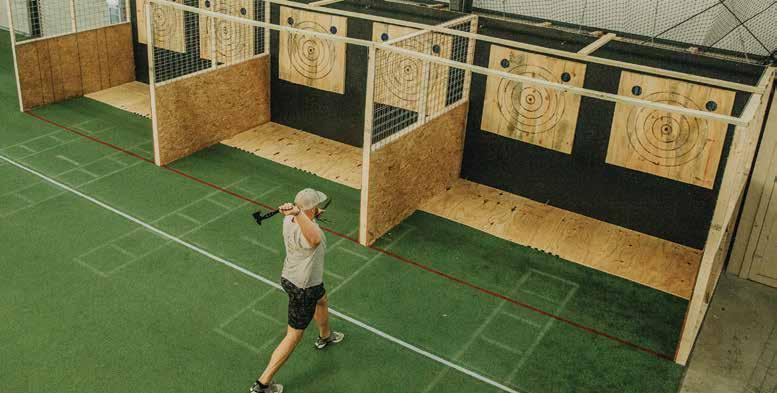
Online pre-booking is highly recommended. Individual throwers pay $25 plus tax for an hour. l
Editor’s note: You can book your axe throwing experience at loganmartinaxe.com.








Efforts begin to save one of St. Clair’s most storied structures
The story of the Looney Family, among the first settlers in St. Clair County and one of the oldest in state of Alabama, begins over 200 years ago on the high, east bank of Tensaw Lake, which had been from an old channel of the Alabama River at a place named Fort Mims.


The fort began as the fortified plantation of early settler Samuel Mims and consisted of 17 buildings, a blockhouse and a log palisade.
Following the victory of the Red Stick Creeks at the Battle of Burnt Corn Creek on July 27, 1813, over 500 settlers from the surrounding area sought refuge at the fortified home. Maj. Daniel Beasley and 70 volunteers of the Mississippi Territorial Militia were sent to garrison the fort, while another 100 volunteers were sent to other nearby posts and forts.
At noon, on Aug. 30, Red Stick warriors, led by William Weatherford, or “Red Eagle,” assaulted the haven by rushing though the fort’s open gate and firing through the gun ports. Maj. Beasley and his militiamen fell during the first part of the enemy’s attack.
It fell to Capt. Dixon Bailey, a Creek, and his force of Americans and Creeks who repelled the hostiles for four hours. The battle ended when the fort’s buildings were set ablaze. The casualties numbered from 300 to over 400, mostly women and children.
Gov. Willie Blount (pronounced “Wylie”) of Tennessee was quick to react and the state legislature authorized him to summon 5,000 troops to defend the Mississippi Territory. Major General of the Tennessee Militia, Andrew Jackson, who was recovering from a near fatal brawl in Nashville, was given command of the volunteer forces.
On Oct. 7, with his arm in a sling, Jackson and his second in command, Gen. John Coffee, departed Camp Blount in Fayetteville. They made their way south and later erected Fort Strother along the Coosa River in present day Ragland.
The Creek War came to a close following the Battle of Horseshoe Bend on March 27, 1814, and many familiar names of places in Alabama came about as result of this often-forgotten war, such as: Moulton and Somerville and the counties of Blount, Coffee, Jackson, Lauderdale, Montgomery and Wilcox.

Among the brave Tennessee volunteers were John Looney and his son Henry, of Maury County. During the war, they had come through this land, helped construct Fort Strother, and fell in love with the beautiful country that surrounded them during the campaign.
In the aftermath, father and son returned to Maury County and in 1816, John began selling his land. In late 1817, he, his wife Rebecca, and their children left Maury County, bound for the land described by Julia Tutwiler,





as “Goodlier than the land that Moses climbed lone Nebo’s mount to see.”
Trusting in the Lord with their hearts and leaning not on their own understandings, the John Looney Family settled in Beaver Valley in 1818, and the site they chose was near a sparkling spring, not far from Little Beaver Creek. They soon began work on their house and were finished by the winter.
The new spring brought with it swarms of mosquitoes, illness from fever and chills and a flooded home. A new home place was found nearby, and the house was moved to higher ground where it has stood ever since.
John Looney became a prominent leader in the young St. Clair County, serving as a justice of the peace and foreman of the first jury. After his death in 1827, Henry became head of the family and married Jane Ash, the daughter of Ashville’s namesake John Ash, on Oct. 25, 1838. Henry departed this life in 1876 at the age of 78 and was interred at Liberty Cemetery in Odenville. Jane moved to Texas around 1888 to live with her son George and died there in 1900, aged 85. She was laid to rest in City Greenwood Cemetery in Weatherford, Texas.
Henry’s siblings were Jack (married to Lucinda Cooper), Asa (Joyce Cooper), Absolom (Nancy Chenault), Sophia (John Cooper), Elizabeth (Wylie Yarbrough), Isaac (Elizabeth Hammond), Wylie (Laurinda Little) and Melinda (Hugh Cooper).


The Looney House, with all its history and dovetailed, heart of pine logs, was sold in the late 1800s by D.W. Looney to John and Eliza Lonnergan. It remained in the Lonnergan Family until it came into the possession of Col. and Mrs. Joseph R. Creitz.
The house, once the perfect picture of pioneer
WE DO WHAT WE DO BECAUSE CHILDREN HAVE DREAMS.
Children born into all kinds of circumstances have dreams and dreams are powerful.

architecture and Southern resolve, was now without a roof, missing many of its window panes and overgrown with honeysuckle. In March 1972, the couple offered the house to the county or any historical organization that would vow to restore the property.
On April 8, 19 people attended the founding meeting of the St. Clair Historical Society at the Odenville Community Center. On Sept. 15, the house and property were given to the St. Clair Historical Society for $10 and by the end of the society’s first year, its membership measured over 500.
Mrs. Mattie Lou (Teague) Crow valiantly led from the front and organized the restoration of the home. A cedar shake roof was installed, window panes were replaced, and the grounds were cleared, with much appreciation being extended to the Ashville Garden Club and the John Pope Eden Career Technical Center.
The front porch was restored by Jack Bowling of
Rainbow City for the cost of around $2,600 and it was said, “It’s as near to the original as we could build it,” as a great deal of research was conducted to determine how the first porch looked.
The rock steps, quarried out of Beaver Mountain and hand hewn, date back to the 1860s and were donated from the old Cox house in Beaver Valley. Wild roses and four o’clocks were planted. For the inside of the house, Miss Nan Young made the rugs and Miss Nellie Patterson made the briar-stitched curtains.
Furnishings and decorations were donated from treasures found in the homes of many St. Clair Countians: Karl Scott donated a pegged rope bed; Ann Riser gave a lovely chest of drawers which opens into a desk; Elizabeth Teague donated a period rocker; and the Rankin Family gave a beautiful wardrobe.
Howard Hill gifted a set of candle molds, which belonged to his grandfather, and his wife, Elizabeth, the great-granddaughter of county pioneers Littleton Yarbrough and Reuben Phillips, donated a reel, for arranging thread, from her great-grandfather Reuben





Phillips’ plantation and a butter mold used by her mother, Sallie (Phillips) Hodges.
The first of the St. Clair Historical Society’s Annual Fall Festivals took place over the weekend of Nov. 23 and 24, 1974, and the grand opening of the museum was attended by a crowd of over 2,000. The ribbon cutting was officiated by Dr. James McClendon, the father of Sen. Jim McClendon, and music was provided by the Springville and St. Clair County High School bands.
The Looney House was soon added to National Register of Historic Places and on Feb. 15, 1975, a certificate, signed by Alabama Gov. George C. Wallace, recognizing this achievement was presented to the St. Clair Historical Society.
In 2018, descendants of John and Rebecca Looney came together from all over Alabama, as well as Arizona, Florida, Georgia, Kentucky, Oklahoma, Ohio, Tennessee, Texas and Utah in a homecoming celebration as part of the St. Clair County Bicentennial.
Until a tragic fire destroyed it on Aug. 6, 2022, it was considered one of the oldest-standing, twostory, dogtrot houses in the state of Alabama. l


In the early morning hours of Saturday, Aug. 6, 2022, tragedy struck the Looney House. The beautiful home was devastated by a fire and was destroyed, and efforts are underway to secure the funds for its rebirth.

Due to the ongoing federal and state investigations being conducted, details of its origin have not been disclosed.
All donations, to aid in the restoration of this historic landmark may be made to the St. Clair Historical Society at P.O. Box 262, Springville, AL 35146.
Remaining structure after the fire, below


Trudy makes several knitted knockers each week.

Mentioning “knitted knockers” usually elicits raised eyebrows, sly grins or outright snickers from people who haven’t heard the term before. Among breast cancer survivors who are familiar with the term, it elicits smiles and sighs of relief.

Knitted knockers are soft, comfortable, handmade breast prosthetics for women who have undergone mastectomies or other breast procedures. Unlike traditional prosthetics, knitted versions are lightweight and gentle on scarred or sensitive skin.
Trudy Mayoros has never had breast cancer. But she has been knitting since she was five years old. So, when she learned about the volunteer organization that provides knitted and crocheted alternatives to expensive, heavy breast prosthetics, free of charge, she was touched. She jumped on the bandwagon immediately.
“I’ve been doing this since 2016, when Lee Ann Clark, county extension coordinator for Alabama Cooperative Extension Services for St. Clair, held a big Pink & Teal Awareness luncheon that October and introduced people in this area to Knitted Knockers,” Trudy says. “October is Breast Cancer Awareness Month, and pink is its color. Teal is for ovarian cancer, and Lee Ann’s sister died of ovarian cancer. After the luncheon, some of us formed a Knitted Knockers group.”
Initially, several women met to knit and crochet the knockers, and their inventory grew well beyond the requests received. So, they sent their inventory to Knitted Knockers headquarters in Washington state. “Currently, we

Knitted Knockers can be colorful or simply beige.

knit as we receive orders and usually specifically for the size and color requested,” Trudy says.
Since its inception in 2011, Knitted Knockers has provided 1,876 handmade knockers to registered medical providers (to give to their patients), 447,871 knitted knockers total and has 4,756 groups involved in the knitting, all on a worldwide basis.


Although her monthly numbers vary now because she makes them upon request, Trudy has knitted at least five dozen pairs, as well as singles, over the past five years. She also knits and crochets about half a dozen blankets and 10-15 hats each month for other charity organizations. Topping her list are the Warm Up America Foundation, a Texas-based organization that supplies blankets, hats and scarves to the homeless; Ann’s New Life Center for Women, located in Cropwell and Leeds, which supplies blankets, booties and caps to new mothers; a couple of Native American charities and the Jimmie Hale Mission in downtown Birmingham.
“I love doing this,” she says. “It’s my thing, my mission.”
She has been a knitter since she was five, when she made a pair of socks for her father. “He was thrilled, but I can imagine what they were like,” she says, in a voice as soft as the pima cotton with which she knits the knockers, and that retains a hint of her Swiss accent.
Born in Switzerland, it makes sense that she knits European or continental fashion. In this style, the yarn is held in the left hand and a subtle movement of the left index finger is used to help the needle pick up the yarn
Relaxing wa Trudy does most of her knitting in a rocker in her craft room hile knitting knockers.
Tools of the trade alongside a scarf that just needs button













and form a new stitch. “American style involves holding the yarn in your right hand and ‘throwing’ it over the needle to form the stitch,” she says. She uses four needles for the knockers, knitting with two, dropping one, then picking up another as she forms the triangular shape. It takes about an hour and a half to knit one knocker.
Most of her orders come from individuals who learn of her service by word of mouth or from their oncologist. When she gets an order, she tries to turn it around in one to two days. “I let them pick the color,” she says. “Beige is the most popular choice, but pink is popular, too. It’s the only time they can pick their size! Believe it or not, most of the time they go smaller (than before surgery).”
Women to whom she has given knockers often send thank-you notes, and sometimes they include a donation. In keeping with the tenets of Knitted Knockers Foundation, she doesn’t charge a cent for her work. If she gets a donation from a grateful wearer, she turns it back into more yarn.
Commercial breast prostheses usually are made of rubber and can weigh 1.5 pounds. They cost more than $100 and make women sweaty, so some just stop wearing them. Knitted knockers, on the other hand, are made from exceptionally soft cotton stuffed with PolyFiberFil, which is non-allergenic. They can be hand or machine washed and hung to dry.
“I order the yarn from a place out West, and they get the cotton from Peru,” Trudy says. “Lion Brand now has a soft yarn called Coboo approved by the Knitted Knockers organization as soft enough for the knockers. It’s a #3 weight, and Walmart is carrying it, so it is a lot less expensive than the yarn I’ve been ordering – about a third of the price.”
She has a dedicated craft room over her garage, where she keeps several WIPs (works in progress). Baby blankets and caps are stacked next to her sewing machine, finished except for weaving in the yarn ends – a dreaded task for most knitters and crocheters.
Along one wall, a stack of plastic, see-through drawers keep her yarn organized by color and weight while also storing magazines and knitting tools. A clear bag houses large foam blocks that fit together like a puzzle. She uses those for wet blocking many of her finished pieces.
Two recliners face a small television that she often watches while knitting. The crocheted antimacassars on the backs of the recliners are her own pattern. She makes up most of her patterns as she knits or crochets, and only learned to read printed ones a few years ago.
“I probably spend two to three hours a day minimum knitting, more if I’m working on special projects,” she says. “I may go up to my craft room around 1 p.m., and work until Emery (her husband) reminds me it’s time for
Trudy loads a bag of baby blankets into car for delivery to Ann’s New Life Center.

dinner. Then after dinner, I’ll knit while we watch TV together in our family room downstairs.”
Like the dozens of hummingbirds at the feeders on her patio, Trudy can’t sit still and do nothing. Apparently, she can’t walk and do nothing, either, as evidenced by the treadmill in her craft room. She tries to walk half an hour a day at the No. 2 speed setting and works while she walks. She knits items that involve a lot of repetition and don’t require her to count stitches.
“I feel I have a gift in serving other people,” Trudy says. “When God blesses you with so much, you don’t sit on your gifts.” l
Editor’s Note: For more information on the free Knitted Knockers program, including a prosthesis pattern and list of accepted yarns, see knittedknockers.org. Trudy is on their knitter list, and you can contact her through their website.








Two years of a pandemic certainly changed the way Pell City Rotarians have operated, but their actions have never wavered from their guiding principle, “Service Above Self.”

As daily routines return more and more to normalcy, Rotarians have emerged with renewed vigor – a new determination – to do even more for their community. A synergy is taking hold as a new generation of leaders are stepping up to build on the legacy of making its community a better place.
“I joined Rotary when I attended Smiths Station High School after learning about what Rotary did for our community,” said Casey Cambron, one of Pell City Rotary’s newer members. “We stayed active in our town, visiting veterans’ homes for Christmas, area cleanups and other various community volunteer activities. As an adult, I still believe in volunteering in our community and found that Rotary was active in my area, and I wanted to give back to my community.”
And give back, he has. In addition to volunteering for a number of causes around the city, he has been involved in Rotary’s Father Daughter Dance. “I have helped with the Father Daughter Dance and seen many young girls spending time with their fathers. Seeing them dance together, spending quality time is an amazing experience.”
One of the local club’s most anticipated events of the year in the community, it wasn’t held in 2021 because of the pandemic, but resourceful Rotarians found a way around it. They created colorfully decorated boxes filled with treats and ideas for special activities for fathers and daughters to share quality time together. Within a week more than 100 boxes had been given away.
In 2022, the dance was back – bigger and better than ever.
“I have had the chance to be involved in multiple fundraising and service projects, but one of the most rewarding has been the Father Daughter Dance,” said Rotarian Matthew Pope. “To see those fathers all dressed up and the sheer joy on the girls’ faces is so awesome.
“As fathers, we have a duty and obligation to show our daughters how they deserve to be treated,” he said. “Hopefully, we are doing that daily, but this gives a specific event where we can be intentional about loving them and ‘modeling’ what their future relationships should look like.”
Rotarians Meg Clements, a lawyer and mother of two, and Blair Goodgame, tourism coordinator for St. Clair County, make the evening a perfect picture by creating an almost magical atmosphere for fathers and daughters with a themed event that follows through with elaborate decorations and attention to every detail. The memories last a lifetime.
The two also team up on a tennis tournament Rotary holds each year around Halloween, and it’s nothing short of being ‘spooktacular.’ One of the club’s major fundraisers, the community comes together around this
tournament – participating, sponsoring, cheering – and it offers an opportunity for competition in a variety of categories.
The club’s oldest fundraiser, chaired by longtime Rotarian Joe Paul Abbott, is the Pell City Rotary Charity Golf Tournament Ray Cox Memorial, another communitywide event that draws golfers from near and far to compete in this impressive display of community spirit.
“The golf tournament brings so many people together for a good cause,” said Abbott. “From the sponsors to the volunteers to the golfers, themselves, it’s a fun-filled day, and the bonus is that the money raised goes right back into the community.”
“When I was in high school, the phrase ‘Service Above Self’ was a quote from Rotary,” Cambron said. “That phrase has stuck with me my entire life. I truly believe that helping your community builds a better community.”
“I have met many great people with our Rotary Club,” Cambron added. “I have been given opportunities outside of Rotary to volunteer with other organizations that are directly connected to Rotarians.”
When Pope joined, he recalled, “I wanted to be part of an organization that focuses on the community and gives me opportunities to serve the community I live in.
I also love the networking and social aspects of Rotary. I have made some lifelong friends and have developed relationships that have helped me learn and grow in my personal and professional life.”
Rotary, he added, is “100 percent focused on the community. As a service organization, our conversations constantly center around ways we can improve, support and strengthen our community and community partners. We help support other nonprofits with monetary donations and service projects. We also fund two scholarships each year for a local high school senior” that can be renewed throughout their college experience.
Weekly meetings of the Rotary Club are more than just a meal. “Our lunch meetings allow me to network weekly with leaders in our community,” Pope said. “We also have fantastic speakers and programs where we have the opportunity to hear inspiring stories, learn about local businesses and organizations and receive updates about things and events going on in our area.”

The benefits are many, members say. Rotary is an investment, but the return is so much greater. “To be able to point to dozens of Rotary-supported worthwhile causes – people and organizations doing great things for our city – to see our city grow, makes me proud,” said Serge Brazzolotto, the club’s president-elect.
“I joined Rotary several years ago only because of its service to community pledge. I spend as much time as I can serving the club needs and fundraising. I came from another country and have been here for many years, and Pell City and its citizens have been good to me. I have been retired for 10 years and since then, I have tried to give my time to help those in need and serve the community and to give back. Rotary was a perfect fit.”
He noted the pride in seeing Rotary’s hand in the Christian Love Pantry, Education Foundation, Community Clinic and a host of others benefitting and flourishing “because of our support,” he said. “In turn, we must thank the community. Because they give us a service that we all need, so it is our duty to give back to them and support them.” l

Dr. James Bedsole Leeds Stained Glass Technical Consulting Services LLC Royal Foods Davis Worley Stone and Son Electrical BSE Industrial Contractors Metro Bank
Lovejoy Realty Joe Paul Abbott, Union State Insurance Hill, Gossett, Kemp & Hufford Patricia Couch State Rep. Randy Wood Byron Woods Municipal Consultants Ford Meter Box Sarah Brazzolotto Wood’s Surfside Marina Goodgame Company Southland Golf Cart Sales Henderson’s Builders Supply Fields & Gossett Realty
Usrey Funeral Home Adam Bain Coosa Valley Mortgage
ASC Allen Service Company State Rep. Jim Hill Bill Hereford
Paul and Marie Manning
Trotter Foundation
Barnett, Jones, Wilson LLC Griffins Jewelers Dot Wood Appraisal Bain and Company
Eden Family Dentistry Bart Perry State Farm The Bline Agency Kilgroe Funeral Home Tradesman Co. Rodney’s Marine Center LLC Billy Murray Brooke Tollison Rock and Jennifer Helms Hugh Holladay
Trussell, Funderburg, Rea, Bell & Furgerson
Hargray Douglas Manufacturing Co. Inc.
JCSC Services Inc.
AOD Federal Credit Union Caran Wilbanks
Lyle Harmon Gallery of Eden Judge Bill Weathington St. Clair EDC
In Memory of Bob Watson National Cement Jackson King-ERA King Robinson Law Firm

Raymond James Gavin Gillison, Warren Averitt
In Memory of Ray and Jimmie Nell Miller Ellison Land Ventures LLC
TENNIS TOURNAMENT
Express Oil Change ERA King
Dr. James W. Bedsole Eye Care Brentwood Child Care Serge and Sarah Brazzolotto
Dot Wood Appraisal Marie and Paul Manning Union State Insurance Union State Bank Trussell, Funderburg, Rea, Bell & Furgerson
Sarah Stewart
Logan Martin Tennis Association
94.1 The River Metro Bank
Pell City Coffee Company
Brittney Smith, Main Street Memories
Melissa McClain, Red Magnolia Photography
DJ Andrew Brumbeloe
Pell City CEPA
City of Pell City Pell City High School Jefferson State Community College
Southland Golf Cart Buffalo Rock And All Our Wonderful Volunteers!
The Rotary Club of Pell City meets at noon every Tuesday at the Pell City Municipal Complex, 1000 Bruce Etheredge Parkway in Pell City, AL. For more information, please visit our website at pellcityrotary.org

Because you give, we can give...
Pell City Rotary Club says thanks to our sponsors of the Ray Cox Memorial Golf Tournament, Rotary Tennis Tournament and Father-Daughter Dance!

Kayaking in Springville has everything you need.
 Story by Loyd McIntosh Submitted Photos
Story by Loyd McIntosh Submitted Photos
We’re standing on the bank looking out onto the Big Canoe Creek checking out the water levels. It’s Saturday, shortly after noon, right around the time the morning Yak Tha Creek tour of Big Canoe Creek would be ending for the day.
Today, however, they had to cancel due to the water levels being too low, an issue the small Ashville-based company has faced all summer long. Today is one of those days. The water at its lowest point is only a foot and a half, too low to safely get the kayaks in the water.
“We don’t like to run under two feet,” explains Madison Vann, the daughter of Yak The Creek’s owner and founder, Randall Vann. She instituted that rule recently after eight of Yak Tha Creek’s Perception sit-on-top kayaks were damaged one weekend after putting in water below two feet in depth. It’s a shame because this five-mile stretch of Big Canoe Creek is spectacular in its scenic beauty, is home to some amazing wildlife best experienced on a kayak. In total, Big Canoe Creek is a 246-mile watershed spanning the northern edge of St. Clair County. Originating in northeast Jefferson County near Zamora Park Lake, Big Canoe Creek flows into the Coosa River in southwest Etowah County ending its run in Neely Henry Lake.
According to the website, The Friends Of The Big Canoe Creek (bigcanoecreek.org), Big Canoe Creek is home to more than 50 species of fish, including the trispot darter, a species that was found in the waters near Springville in 2008.
Prior to its rediscovery, the trispot darter was thought to have disappeared from Alabama waterways as early as the 1950s. It’s surprises like these that kayakers are treated to barely a stone’s throw away from the busyness of the area’s highways and interstates.
“There’s all different kinds of fish. We even got some alligator gar out there. If you kayak real slow, they’ll rise to the top. It’s so cool,” Vann says. “We’ve got groundhogs, raccoons and lots of lots of turtles. Oh, my goodness, we have an insane amount of turtles. And there’s a ton of mussels.”
In fact, there are eight federally listed freshwater mussel species known to be living in Big Canoe Creek. Additionally, a section of the creek stretching for 18 miles was designated “critical habitat” under the Endangered Species Act in 2004 and a new species, known as the Canoe Creek clubshell, was recently identified living in one of the Big Canoe Creek watershed tributaries.
For the past seven years, Yak Tha Creek has been taking people on kayak tours on a five-mile portion of Big Canoe Creek. Originally launched by Randall Vann, the director of Maintenance at Spartan Invest in Birmingham, the business has been turned over to the next generation of Vanns. “It’s me, my dad, and my brother Mason. Dad kind of lets me and Mason run a lot of it since we’ve been doing it so long,” says Madison Vann. “Every once in a while, we’ll hire some high school kids to help out because hauling those kayaks can be kind of rough.”
Yak Tha Creek uses nine-and-a-half foot, sit-on-top kayaks, which Vann says don’t hold water like the more traditional sit-inside kayaks. It has other benefits, too. One doesn’t typically find wildlife hiding on sit-on-top kayaks. “I’d rather not stick my leg in there and find a snake in there,” Vann says before erupting into laughter. “Someone the other day told me he had left a fish in there all summer long; I don’t know what I would have done. Probably thrown the kayak away!”
Yak Tha Creek operates weekends, typically between Memorial Day to Labor Day but may extend the season depending on demand. They put in on Doss Lane just off Pinedale Road with the exit point five miles away on state property in the shadow of the U.S. Highway 231 bridge less than a mile from downtown Ashville.
Each Friday, the Vanns work their stretch of the creek, clearing trees and other debris. The route typically takes three to four hours to complete and is suitable for the beginner learning the ropes and the expert looking for a more relaxing, low-key day on the water.
“It’s a good, easy beginner’s creek, though. There’s nothing rough about it unless the water is high,” Vann adds. “It’s a super easy kayak for beginners. I have seven year olds come out here and do it.”
Even though she says maintaining the creek is hard work, she never grows tired of kayaking Big Canoe. “There’s so much stuff out there to find. I’m a treasure hunter. There’s crazy stuff out there,” Vann says.
Among the items she’s uncovered over the years include cellphones, teacups, and a complete set of Mason jars buried in the dirt, most likely holding some forgotten-about moonshine from an old still hidden in the bank along the stretch of the creek. “There was a guy out here one day sifting for gold up the stream a little farther,” Vann says. “I don’t know if he ever found any.”
Approximately 30 minutes southwest in Springville is another family-owned kayak business – Big Canoe Creek Outfitters. Owned and operated by the Shaffers, a family originally from Mountain Brook with a short stop in Trussville in between, they bought the property earlier this spring, accidentally becoming business owners in the process.
“The kayak business came with the purchase of the house,” says Robert Shaffer, the patriarch of the family. “Honestly, we didn’t know there was this kayak business when we first looked at the property in April.”
Much like Yak Tha Creek, the Shaffers turned the business over to their teenage sons, Thomas and Lyons. Essentially a summer job for the Shaffer brothers, Big Canoe Creek Outfitters opened for the 2022 season on Memorial Day weekend.
Lyons, a student at Auburn University, says the previous owners left the kayaks and other equipment in good shape, so all that was necessary was some cleaning

and general maintenance – as well as learning how to run the business. “We were learning as we were going in the beginning because we did not know a lot,” says Lyons.
For example, Lyons says he was surprised at the biodiversity of Big Canoe Creek. “I did not realize how much wildlife there would actually be in just a simple creek, but there are so many different types of fish,” he notes. According to the Big Canoe Creek website, the 3.85-mile section on which the Shaffers offer tours is home to many interesting species of birds, including great egrets, barred owls and bald eagles.
With the first summer under their belts, Lyons says he believes they can expand Big Canoe Creek Outfitters’ offerings in the summers to come. “We definitely would like to expand and get some boats so we can accommodate bigger parties,” Lyons says. “We just needed to learn what we were doing first so now we can actually grow.”

As the conversation with Madison Vann started to wind down, a pair of kayakers row to the exit point having just completed a long morning on Big Canoe Creek. Van Lyvers, a resident of Pinson, and Bart Albritton, from Odenville, are friends who have kayaked many waterways throughout Alabama but had never kayaked Big Canoe Creek until today.

They’re all smiles as they pull their boats onto the bank and load them into the bed of Albritton’s pickup truck. The guys say they enjoyed the creek even if the water was quite low in some places. “We’ve seen worse, but it was kind of low,” says Livers. “If it had just a little more water it would have made all the difference in the world.”
“What you see is what it is. There are no rapids, and it’s just leisurely and fun,” says Albritton. “We saw some highlegged woodpeckers, some kingfishers, but unfortunately no snakes.
“I highly recommend it,” adds Albritton. “It was beautiful, scenic and just awesome.”
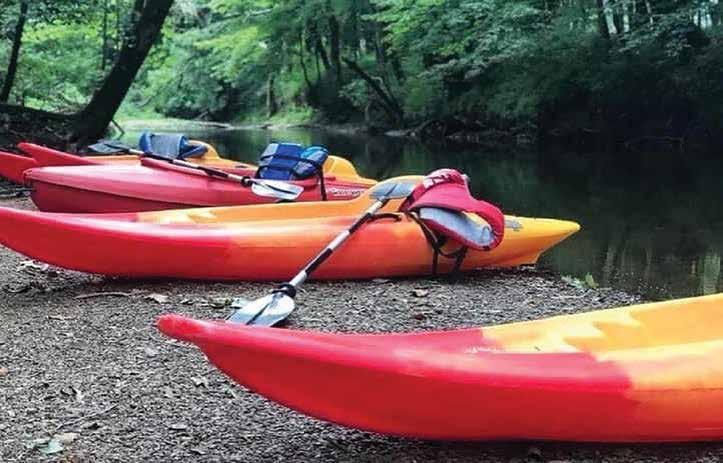










When the day-to-day demands begin to get overwhelming, Urainah Glidewell knows it’s time for a little outdoor therapy. That’s when she laces up her hiking boots and heads for the woods in search of the road – or trail – less traveled and the joy she finds out in nature.
“Hiking is one of my favorite things to do,” she said. “Getting away from technology and the stresses of life is very peaceful and calming. It really helps to clear your mind. We focus on the things around us, and when
the things around us are calming, you feel more calm within.”
Glidewell doesn’t have to go far to find the peace she craves. St. Clair County, nestled at the foot of the Appalachian Mountains, has an ever-growing list of beautiful options for getting away from it all. And fall, with its cooler temps and breathtaking colors, is the perfect time to plan an escape.
It’s one of Josh Reyes’ favorite times to head to one of his preferred places, Horse Pens 40, an historic park at the top of Chandler Mountain in Steele featuring ancient rock formations. Although Reyes, an avid boulderer, goes for the climbing, he usually can’t resist heading to the end

of the trail that overlooks the valley. “It makes for some gorgeous sunsets,” he said. “It’s a beautiful view you don’t have to work hard to get to.”
Enjoying the beauty that St. Clair County has to offer is the main draw for Glidewell. “For me, it’s being out in nature, enjoying the flora and fauna and seeing If I can spot any animals,” she said. “I’m not as focused on how many steps I’ve taken. Pretty soon, I’ve hiked five miles, and it doesn’t feel like it. Five miles on a treadmill feels a lot different.”
Regardless of whether you have time for just a quick trek or a full day to explore, finding a change of scenery and mindset is as easy as putting one foot in front of the other. So, when you’re ready to hit the trails, here are some places to start:

Sumatanga Camp and Conference Center, founded as a United Methodist camping ministry in Gallant, offers a one-mile Mountain Trail that ends at Creel Chapel at the top of Chandler Mountain. There is also the paved Rosenau Lake Trail that begins at Pool Camp, the historic center of the facility that includes eight original cabins and winds around Lake Sumatanga.
The trails are open to the public from August to May but are reserved for campers during June and July, according to Camp Sumatanga’s Leslie McClendon. Visitors are asked to check in at the lodge, where trail maps are available, so the staff can know who is on the property. Dogs must be leashed, and no one is allowed on the trails at night.
“Sumatanga” is the Himalayan word for a place of rest and vision, and that’s exactly what hikers can expect to find. Although considered a more moderate hike, the Mountain Trail is the most popular because of the beautiful view from the chapel. “It’s just you, nature and God,” McClendon said. “We always say that if you can’t find God at Sumatanga, you can’t find God.”
For information and directions, visit www.sumatanga. org.
Part of The Preserves, Alabama Power’s public-use properties, Double Cove Park was previously known as Logan Martin Dam Park. The day-use park, open from daylight to dusk, features a beach and swimming area, two fishing piers, grills, picnic tables, restrooms, and pavilions, as well as a view of Logan Martin dam. The park also boasts a playground and several trails ranging from just over a mile to just under two miles. Although leashed dogs are allowed on the trails, they are not allowed at the park.
“This, for me, is a hidden gem,” Glidewell said. “They have some absolutely beautiful trails going back through the woods with some wonderful benches and gazebos tucked away.”
Alabama Power offers more than 70 public-use properties around 12 reservoirs on the Coosa, Tallapoosa
and Black Warrior rivers. Some are boat launches or picnic spots while others, like Double Cove, have a number of amenities.
“We have some wonderful recreation sites, and they’re all free for everyone’s use,” said Josh Yerby, a team leader for Alabama Power’s Shoreline Recreation. For more information and directions, visit www. apcpreserves.com
Horse Pens 40, with what Reyes calls its “corridors of beautifully sculpted sandstone formations,” is well known and respected in climbing circles and is one of three sites in the Triple Crown Bouldering Series.
“We have a lot more people from out of state than instate come visit,” said Ashley Ensign, a member of the Schultz family that operates the park. “We have people who come out and stay for an hour or come and stay all day. There’s lots to explore.”
The park is home to 60 rare, threatened, protected or endangered species, and Ensign said it’s like an undeveloped Rock City. “There’s no concrete pathway,
nothing is paved,” she said. Instead, the trails wind around the ancient boulder field, ending at the overlook that Reyes and others have come to love. “It’s a beautiful place with absolutely beautiful trails and a lot of history,” Glidewell said.
Billed by the family as “the South’s best kept secret,” Horse Pens 40 was occupied by Native Americans, including the Creeks and Cherokees. “The first humans to see the mountain would have considered it a huge fortress that could provide them protection, shelter, food and water throughout the year,” according to the website.
The boulders form a natural corral, and “it’s called Horse Pens 40 because the Native Americans chased wild horses and herded them up so they could break them and tame them,” said Reyes. He lives in Jacksonville but has become something of an expert about the park he’s been visiting for 20 years, usually two or three times a month. “It reminds us that we weren’t the first ones here.”
In addition to trails and boulders, the park, open from 8 a.m. to 6 p.m., offers primitive camping, RV hookups, eight cabins, picnic areas and a playground. No dogs are allowed in the park, and the day use fee is $10 per person. Children under 10 are admitted free.
For information and directions, visit www.hp40com.
If you want proof that getting away from it all doesn’t mean you have to go far, look no further than Lakeside Park in Pell City. Next to the Civic Center on Stemley Bridge Road, the park is built on 65 acres and is a

beautiful oasis bordering Logan Martin Lake.
“If you have a quick 15 or 30 minutes and want a nice place to get out and experience some beautiful nature and get some exercise, it’s a great place to do it,” Glidewell said. “If people are just starting out it’s an easy trial. The walking track goes along the lake and there’s a trail through the woods as well.”
The Native Plant Walking Trail, a project of the Pell City Garden Club that spans two acres, is only one draw of the park, where many people go to spend the day.
Along the way, discover Wetlands Boardwalk Project, an effort by Logan Martin Lake Protection Association to preserve Logan Martin’s wetlands area and to raise awareness about the critical role wetlands plays in the environment and to educate youths on its importance.
A hand-built, 70-foot walkway guides you into the natural wetlands, and a 40-by-12-foot observation platform allows you to take in the scenery and sounds of nature. Signs from the platform identify the plants seen from the boardwalk and observation deck.

But the walking trail doesn’t end there, it also winds around the park, which features a beach and swimming area, boat launch, restrooms, picnic tables, pavilions, fishing piers and an amphitheater available for rent, and a newly rebuilt Kids Kastle playground that is a hit with kids of all ages. During the summer months, the Splash Pad is a popular destination.
The park is open from 6:30 a.m. to sunset. Dogs are allowed but must be on leashes. For more information, visit www.pell-city.com/lakeside-park.
Another of The Preserves’ offerings, Ten Island Historic Park in Ragland, has a long and storied past. Some speculate that the Spanish explorer Hernando de Soto, crossed the river at this point in the 1540s, according to Alabama Power’s website for the Preserves.
The indigenous Creek first named the site of this park “Oti Palin,” which means Ten Islands, after a series of small islands along the Coosa River, the majority of which no longer exists. The Creeks settled on the largest island, Wood Island, which was later used when Neely Henry Dam was constructed.
Today, the park, which is open from 5 a.m. to 9 p.m. and is part of the Alabama Birding Trails, is considered one of the best public spots for bird watching. Ten Islands offers a boat launch, beach and swimming area, restrooms, multiple picnic pavilions and tables, two fishing piers and gazebos. And although the trails, which total nearly two miles, have long been a big draw, the opportunity to travel through the woods has been opened up to even more people.
“We’ve cut another trail into the woods with ADA (Americans with Disabilities Act) compliant slopes,” Yerby said of the project that was scheduled to be in September. “It runs alongside the other trail and connects them at certain points, so it will add about another ¾ of a mile.”
The new trail will give those who use wheelchairs “the experience of being in a truly wooded area on a nature trail,” he said. “We have projects like this going on all over the state.”
Dogs on leashes are allowed on the trails, but not in the park area. For information and directions, visit www. apcpreserves.com

Big Canoe Creek Nature Preserve, a 422-acre Forever Wild property, will soon offer even more options for hiking in St. Clair County. The groundbreaking for the project was held in March, and plans call for a series of trails that will eventually cross the preserve.
For more information, visit springvilleparksandrec. com or bigcanoecreekpreserve.org.


 Story Paul South Photos by Graham Hadley Submitted photos
Story Paul South Photos by Graham Hadley Submitted photos
Even as a kid, Houston Lee Tumlin “lit up a room” when he entered. The moviegoing public saw his light in the movie, Talladega Nights: The Ballad of Ricky Bobby, where Tumlin played Walker Bobby, the oldest son of Ricky, played by Will Ferrell.
He played the part to the hilt, his mom, Michelle, remembered. But when the cameras stopped rolling, the then-13-year-old went back to his St. Clair County raising.
“They would be filming, and he would just be cussing people out. But when they would go to break, he would say, ‘May I have a bag of chips?’”
The astonished cast and crew wondered where
the on-camera kid with potty mouth had gone.
“They were all wondering where those manners came from,” Michelle says.
But that was Houston, a class clown and sometimes “hot mess” who loved to make people laugh, who would defend bullied classmates, and competed in sports at Victory Christian Academy, especially football.
Competition began for him as a toddler -baseball, soccer, wrestling, even dabbling in mixed martial arts.
After high school, he joined the Army, earning medals and commendations and numerous training certifications, serving stateside and in South Korea in the storied 101st Airborne, based at Fort Campbell, Ky.
Among his honors: the Army Commendation Medal, the Army Achievement Medal, the Army Good Conduct Medal and the Non-Commissioned

Officer Professional Development Medal and many others.
“He was a badass,” his mom says with a laugh.
But in his last military posting, life took a tragic turn for Houston Tumlin.


“The year in Korea was not good for him,” Michelle Tumlin says. “There was a lot of bad stuff that happened. “
But on March 23, 2021, the light turned to the deepest darkness. Suffering from PTSD (post-traumatic stress disorder) and what researchers at Boston University later determined was CTE (Chronic Traumatic Encephalopathy), Houston took his own life. For Michelle Tumlin, “It was the worst day of my life. The thing that I hold onto is that the doctors said to me that the CTE took away his impulse control. He had an on-off switch, and his flipped that day.
“You add the brain damage and some personal stuff and then you add the bad stuff that happened in Korea, and it was literally the reason he got out of the military.”
Daily, 22 past or present American service personnel commit suicide, their brains shaken by the blasts of battlefields, souls shredded by nightmarish memories, or concussions caused in competition. In Tumlin’s case, between sports and military service and two car accidents, he suffered an estimated 22 concussions between the ages of 14 and 28, Michelle Tumlin says. Those injuries triggered personality changes, alcoholism and changed Houston. His light was gradually fading to black. Depression, alcoholism, multiple head trauma: the recipe for CTE.
“He suffered the last four years of his life,” she says. “It was confirmed after a brain study at Boston University



that he had CTE.” Among other contributing factors, “That’s the reason he committed suicide.”
CTE triggered his symptoms –headaches, happy one minute, sad the next, anger from out of nowhere and a descent into becoming what his mom called, “a straight-up alcoholic.”
“When he was drinking beer with a group of friends, he was fine. When he drank liquor, he would turn into the saddest, most depressed person who never thought he was good. He became a completely different person. That had a huge impact on him doing what he did. It was his kryptonite.”
The Tumlins are one of a growing number of military and NFL families that have donated their loved one’s brain for research at BU. CTE can only be determined after death.

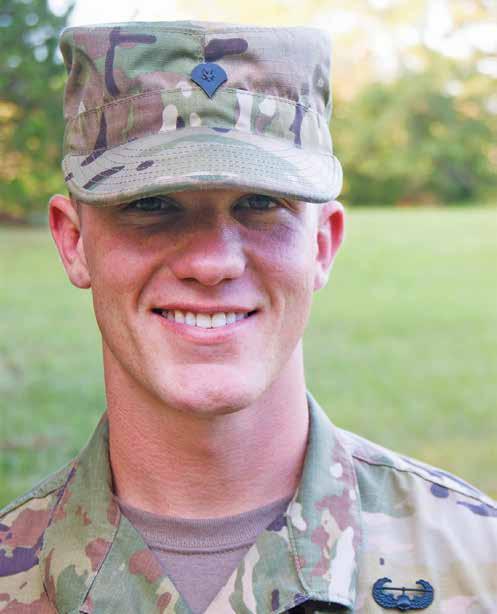
While the Tumlin family’s grief will never die, a year to the day after Houston’s death, Michelle opened the nonprofit Houston Project. Proceeds from the sale of patriotic hats, T-shirts, popcorn, candles and “a little bit of everything” at the store go to help vets and their families. Every cent goes to veterans and their families.
Houston in uniform
The Houston Project, in the Monkey Bizniss shop, is full of specialty merchandise.
In the Cogswell Avenue storefront, Michelle Tumlin fights a quiet battle. Armed with smiles and encouragement, she wants to give veterans hope.
“I started Houston Project because I needed something in my life that felt good, but to also raise awareness for mental problems, PTSD, alcoholism, CTE – all of the above – mental health, period. Raising awareness was important to me.”
She adds, “I wanted to do both of those things and honor my son.”

While the focus of the project is on veterans, the Houston Project is working with other area organizations to help in the fight against mental illness.
“Mental health is important, whether you are a veteran or not,” Tumlin says. “My platform is to be my son’s voice here on this earth. I’m here to tell his story and to try to keep others from doing what Houston did and help give them awareness before it gets to that. That’s why I exist.”
In other times in other wars, PTSD went by other names: shell shock, soldier’s complaint, combat fatigue or war neurosis. The historical record dates such illness as early as 2,600 years ago. And while researchers and medical professionals know more about PTSD, Tumlin believes veterans aren’t receiving adequate help.
“When (service personnel) get out of the military, they need a way to get back to who they were before they joined the military,” Tumlin says. “The


military teaches them to be strong and to be tough and to be soldiers. It was hard for Houston to feel normal again. Not being in the military, he just didn’t feel right, if that makes sense.He couldn’t find his way.”
Houston missed the camaraderie of the military.

“He struggled with depression, nonstop. He was a happy person and a funny person. But he couldn’t find his right place.”
While Army Specialist E-4 Houston Lee Tumlin is gone, he is far from forgotten. While at the time of his death, sordid celebrity news outlets centered on the “Child Actor Commits Suicide” angle, so many others – in Pell City, in the Army and elsewhere – remembered him as so much more – son, brother, fiancé, a soldier who served his country with honor.

Houston Tumlin packed a lot of living into 28 years.
“He walked into a room and took it over. He had the most beautiful smile. He could make people laugh. I mean, the people that started reaching out to us after
There is something for everyone for sale in the store.
he passed – from all of these soldiers from all over the map – messaging us, calling us, telling us it was his goal to make people happy,” Michelle says.
There is another story that the Tumlins heard about their son, from a girl recounting the story of a date she had with Houston in the cold of winter.
“She said they were driving in downtown Birmingham,” Michelle recalls. “Houston stopped the car and told her he’d be right back. He got a coat from the back of the car, locked the car, and took the coat to a homeless man across the street. Hearing these stories just filled my heart. I could not be a prouder Mom.”
The Houston Project, created by a grieving family to help veterans and to honor their fallen son, not only helps vets with things like household repairs and moving expenses. It recently helped a veteran’s family in a poignant, particular way, a fitting tribute to the kid who lit up a room.

It paid the family’s utility bill and kept the lights glowing.
Editor’s Note: The nonprofit Houston Project is open Thursdays and Fridays from 11 a.m. until 5 p.m. The store is located at 1916 Cogswell Ave. in Pell City. Find the store on Facebook. Every cent of sales goes to help local veterans and their families.

A photo of Houston next to bags made from military gear.


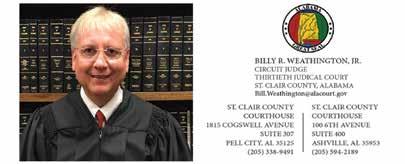










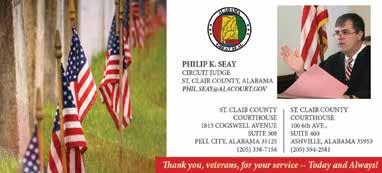









As the country honors its veterans this Veterans Day, Pell City is celebrating the 10th anniversary of its innovative Col. Robert L. Howard State Veterans Home. This year’s celebration includes a party with special guests, along with a road trip to participate in the 75th Birmingham Veterans Day Parade.
Twelve years ago, construction began on a state-of-theart facility for veterans on 26 acres of land in Pell City donated by the St. Clair County Economic Development Council. After two years of construction, the $50-million home opened its doors. Named for Col. Robert L. Howard, a highly decorated United States Army Special Forces officer from Opelika, it was one of a handful like it across the nation.
What’s different about Pell City’s veterans home is both the design and management. It was built using the “Green House Model,” a design concept that features residential
houses built in small neighborhood-style configurations. This contrasts the more typical multi-bed, multi-hall, singlebuilding style of nursing home.
In the case of the Col. Robert L. Howard Veterans Home, the 240,000-square-foot facility has three neighborhoods, each with three 14-bedroom houses. The houses also have their own common spaces, including living rooms, dining rooms, staffed kitchens and porches. A single roof connects all three neighborhoods, so residents and staff do not have to go out in the weather to get from one place to another.
Gone, too, are the bustling nurses’ stations. Instead, smaller “home offices” contain the computers and information nursing staff need to assist the residents of a particular house. Specialized nursing equipment is tucked neatly away in storage rooms.
The structures are designed to feel like single-family homes, with services in the neighborhood like you might find in a typical town. Residents can go to the main building, called the “Town Center,” for services including dining options; physical, occupational or speech therapy; and even a haircut. Residents can use the onsite medical director as








their family doctor, while still going off property to see specialists.
An unexpected benefit of the smaller-home style of skilled nursing care became evident at the onset of the pandemic. “Having private rooms and smaller units definitely helped keep COVID from spreading,” said director Hiliary Hardwick.
The Green House Model advantage is not just about facilities, though. The staff offer residents choices in most aspects of the daily schedule. Whether the choice is what time to get up, what to eat, or when to eat, the choices at Col. Robert L. Howard Veterans Home honor the veteran’s dignity and quality of life.
Over the past decade, delegations from several different states have come to town to see how this model facility works. Most recently, the veterans home hosted groups from Mississippi, Idaho and Oklahoma looking to experience the real-life application of the Green House Model prior to planning for their own veterans homes.
The Pell City veteran residents are happy to have been among the first in the country to take advantage of the new style of home. “I want to thank the people of Pell City and all of Alabama for building this place,” says WWII veteran Robert Curl. Showing the day’s menu choices, he adds, “Look at what we get to eat! I tell everyone I live in a country club. It’s a really great place.”
Talladega native and veteran Kenneth Scoggins agrees. He moved in just four months after it opened and has served as president of the residents’ council for the last seven years. “It’s great, very clean and none of those smells you smell at other places,” he says. “I told someone (when I moved in) that I must have died and gone to nursing home heaven. We do things all the time, even go to ball games and out to eat.”
“We do have a lot to do around here,” agrees Hardwick. “There are always activities offered. We have Bible studies, pet therapy visits, musical guests, and special speakers. James Spann, author and weatherman from ABC 33/40, was recently here with us.”
The facility does have a waiting list of nine months to a year, but Hardwick encourages anyone who qualifies to fill out an application. Qualifications include having served a minimum of 90 days of active duty, with at least one of those days having been during a period of war; having been honorably discharged and having been evaluated for medical needs.
Hardwick was a nurse at Trinity Hospital before leaving to help open the Pell City veterans facility. It’s a move she is very happy to have made. Her enthusiasm for her work is evident when she talks about the residents she spends time with each day. “I love being here where I get to interact with and help people who lived and breathed the history I’ve only read about in history books,” she says.
The 254 residents look forward to all holidays, Hardwick says, but none as much as they do Christmas. “At Christmas time, it looks like you’ve gone to Gatlinburg, we have so many trees decorated,” she explains. “We have an angel tree that we do for the veterans. People can take an angel off the
tree and buy a couple of things a veteran wanted. Then at their Christmas party, they have gifts to open.”
Hardwick encourages anyone to get in touch with her if you would like to participate in the angel tree, help with the home’s benevolence fund or even donate bingo prizes. They also have in-person volunteer opportunities for those who might like to spend some time visiting a veteran.

Editor’s Note: To apply to the Col. Robert L. Howard Veterans Home, contact them at www.va.alabama.gov. For volunteer opportunities, contact Hiliary Hardwick at 205338-6487.



D-Day vet remembers that day, many more at age 97
Story by Roxann Edsall Photos by Richard RybkaRobert L. Curl was just a boy, like so many others, when he enlisted in the Navy. It was the summer of 1943, just a day after graduating from Minor High School in Adamsville. He had to take his dad with him to sign his enlistment papers because he was only 17. “My dad told me he wished he could go with me,” remembers Curl. “He was the best man I’ve ever known.”
The next three and a half years would take him all over the world as a member of the special amphibious unit, “Scouts and Raiders.” A precursor to the modern-day SEAL teams, these special forces were expected to identify landing beaches for troops during World War II and to lead forces to those landing zones.
Curl was a radarman aboard a Landing Cruise Control (LLC) headed to Normandy leading up to D-Day. It was his job on LCC10 to find Omaha Beach and lead the first two waves of soldiers ashore. “That morning I was scared to death,” he recalls, “But I told myself I’m going to do my best. They had me wear an impregnable suit with a special armband that would change color to let us know if the Germans were using poison gas.”
They had already practiced the invasion during a top-secret mission called Operation Tiger, performed less than two months before. To prepare the Allied Forces as much as possible, this full-scale rehearsal for D-Day took place on the south coast of England. “It’s a good thing we did it,” said Curl. “There was a problem with what they called the Mae West lifejacket. During Operation Tiger, these were new, and the soldiers didn’t wear them right. So many people died in the waters because of that. They learned from it and taught people how to use them right.”
Veteran Robert Curl shows a V-mail he sent to his sweetheart during
World War II.
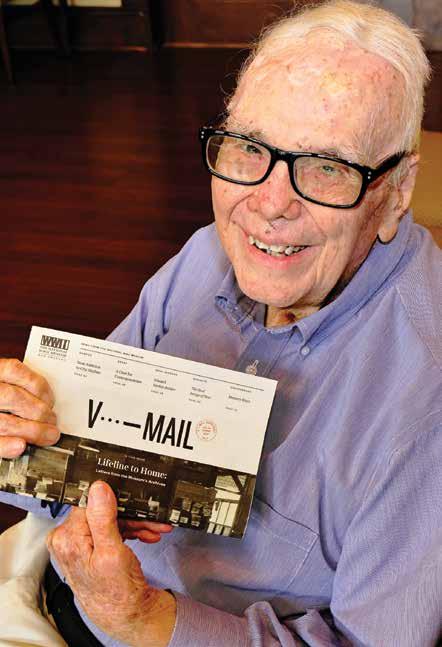





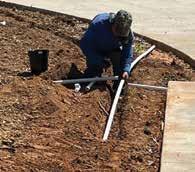

At 97 years old, Curl is sharp as a tack and recalls stories with vivid detail. Despite the wartime and personal tragedy he has experienced, he is one of the most positive and genuinely happy people you could ever meet.
He spent more than 70 years with the love of his life, whom he met just before the war. When he talks about his Nell (Spring) Curl, his face beams.
He met her the first Sunday after his Methodist minister father moved them to a new town. “When we got to church that day, I saw the most beautiful girl in the world doing the devotion,” Curl tells. “I leaned over to the guy next to me and told him I was going to marry
that girl.”
He had to wait until the end of the war, but in 1946, he married his sweetheart. He shows me a piece of Victory Mail (V-Mail) that he sent to her during Operation Tiger dated “April 1944 – from somewhere in England.”
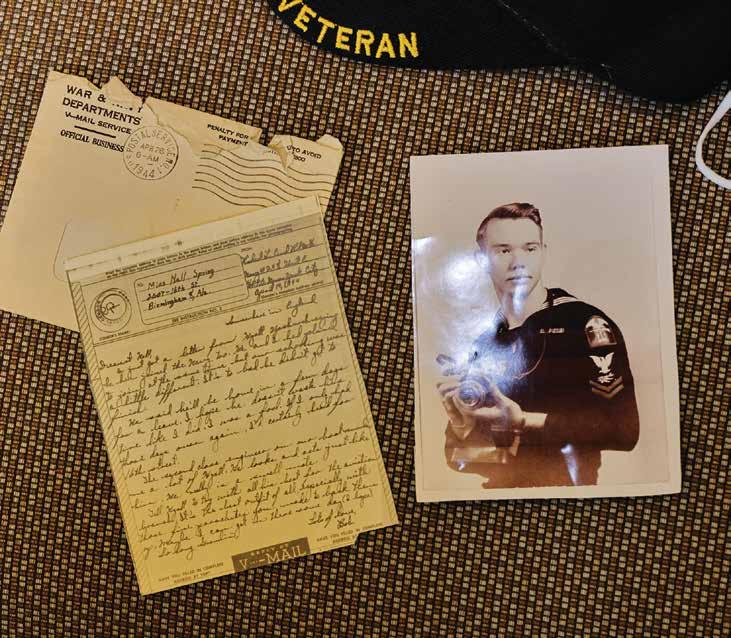
Though she passed away in 2015, he still talks to her every evening before bed.
Curl still drives and often goes on road trips with his two sons, Rick and David. He tells of his first car, long since traded. “Ever heard of a Crosley,” he asks. “I had a ’46 Crosley and it had a whopping 46-horsepower engine the size of a carton of cigarettes,” he adds, laughing.
Radarman Curl writes to his Nell from “somewhere in England” because the mission is top secret.












St. Clair Economic Development Council Executive Director Don Smith talks about Ellison’s contributions as Mayor Bill Pruitt (left) and City Manager Brian Muenger listen.


When ceremonial shovels hit the ground, sending symbolic dirt flying, it signaled a new level of growth for Pell City and St. Clair County.
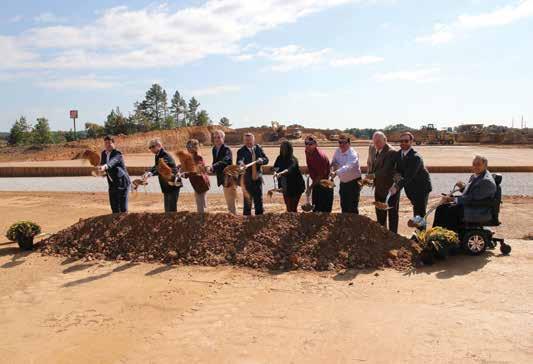
It has been a long, tough road, but three years later, Pell City Square, a 147,500-square-foot retail and lifestyle center is now official. Officials broke ground Sept. 8 on the 19.5-acre site fronting I-20. It closed the chapter on another historic groundbreaking – St. Clair Regional Hospital decades ago – and opened a new one on the future of the ninth fastest growing city in the state.
It will include retailers Hobby Lobby, T.J. Maxx, Ross Dress for Less, Old Navy, Five Below, Ulta Beauty, PetSmart, Rack Room Shoes and other retailers not announced yet. They describe it as a multi-use lifestyle center, which includes outparcels for such developments as sit-down restaurants and is the largest retail investment announcement in St. Clair County since Springville Station Shopping Center in 2005.
Not COVID, not complex partnerships, legal red tape nor any other hurdle would stop this partnership of Noon Real Estate, St. Clair County Commission, City of Pell City and the St. Clair County Economic Development Council.
“They never stopped working,” said Don Smith, executive director of St. Clair EDC. “They banded together to keep moving forward.”
“I share Don’s excitement,” added Pell City Manager Brian Muenger. “This day has been coming for so
long. The mayor and council were unwavering in pushing this project to completion.”
In 1968, officials were celebrating the laying of the cornerstone of St. Clair County Hospital. The county’s population stood between 26,000 and 28,000. Today, it tops the 95,000 mark. Pell City was a community of 5,000 people. Today, 15,000 call it home.
“We’re growing,” explained Muenger, and needs change. City officials kept hearing from citizens that they wanted “to keep their dollars here. This shopping center is going to do exactly that.
Muenger talked about the impact of a massive shopping center on a city the size of Pell City, benefitting schools and providing funds for infrastructure to better serve its citizens. “This is a great day for the city. It took a lot to get here.”
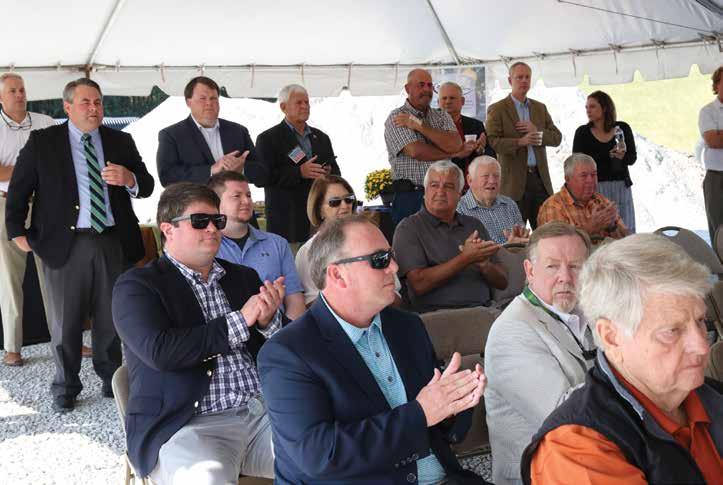
Located at the corner of Interstate 20 and U.S. 231 South, it will sit on the site of the former hospital. The property came under ownership of the St. Clair County Commission and the City of Pell City in 2011 to enable building Ascension St. Vincent’s St. Clair, a state-of-theart hospital just across the interstate.
After years of planning and negotiation, officials
agreed to highest and best use would be negotiate an agreement with Noon Real Estate, a seasoned development firm with plenty of retail experience. The goal was to bring in name brand retailers to keep shoppers in the county rather than spending those dollars elsewhere.
“The county commission has a history of supporting our communities to create new tax revenues and jobs in St. Clair County,” said Commission Chairman Paul Manning. “We believe this project will allow us to continue to grow St. Clair County’s economy while filling a retail need in the community.”
Muenger agreed. “The construction of the Pell City Square development is transformational for the city and its residents. The addition of these national retailers will provide our citizens with more options to shop locally than ever before.”
“It’s been four years in coming,” said Noon Real Estate President Kevin Jennings. He thanked “the team” that made it happen, but he singled out a key player that provided the spark. “It all started with Bill Ellison,” who met him at a shopping center convention in Las Vegas to pitch the benefits of locating in Pell City. “Here we sit









seeing this happen. Come back next fall and bring your credit card.”
Jennings’ partner, Jamey Flegal, said Ellison’s “vision and passion sold us on it,” and he credited another key player with closing the deal – Council President Jud Alverson, who pored over the numbers to ensure the deal not only could happen but would benefit all involved. Calling him “a rock star,” he said the city should be proud to have him in leadership. “It is rare to have leadership understand the numbers.”
Metro Bank is handling the financing for this project, and Smith lauded the bank’s involvement. “They are an incredible asset to this community.”

He also thanked attorneys John Rea of Trussell, Funderburg, Rea, Bell & Furgerson and James Hill of Hill, Gossett, Kemp & Hufford with helping the team over all the legal hurdles en route to the historic groundbreaking.

In another historic move that day, officials unveiled a new sign for the I-20 bridge connecting the northern and southern sides of the interstate as William C. Ellison Bridge.
Mayor Bill Pruitt talked of Pell City’s “great potential” and how “Bill Ellison saw that.” To Ellison’s credit are developments leading to the commercial district anchored by Walmart Supercenter, the South Park Shopping Center anchored by Publix and now, Pell City Square. Those developments generate 40% of Pell City’s tax revenues.
Humbled by the recognition, Ellison said, “I put my heart and soul into my work every day because I love Pell City.”










Muenger,
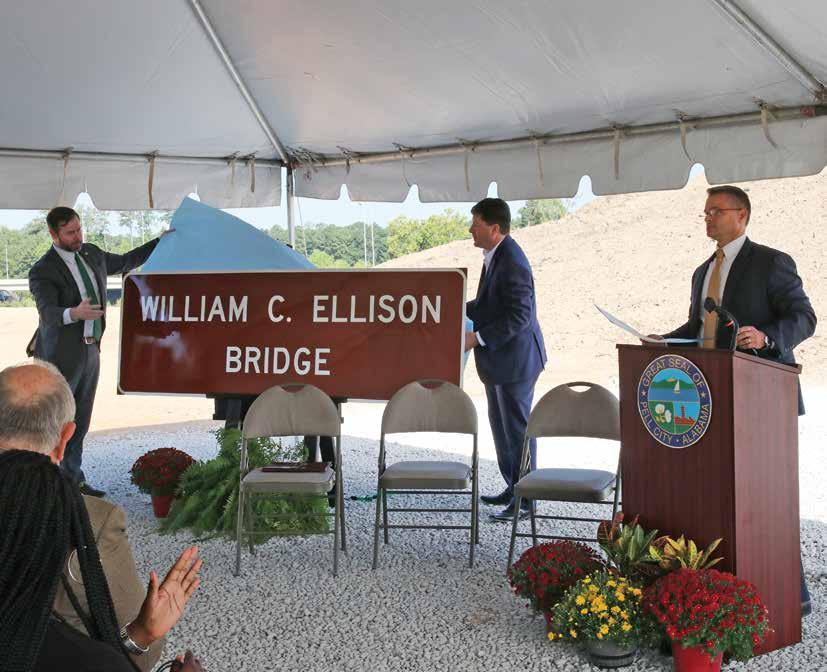
When you travel over Pell City’s William C. Ellison Bridge on U.S. 231 over Interstate 20 in years to come, no need to wonder who that namesake might be.
It is hard to look around Pell City and not see a connection to Bill Ellison, even if you’ve never met him. The legacy of his work may be in the grocery store you shop, the mega retail center where you buy clothes, gifts and products for your home or business.
Find it in the hotels where family and friends may stay while visiting or watching a movie at the cinema. The connection is there even when you sit down to eat at a restaurant, enter your favorite fast-food drive-through or fill up your vehicle with gas.
Over the past four decades, Ellison has been the visionary who saw needs in his adopted, beloved hometown of Pell City and blazed many a trail to fill them. A developer by trade and serving as president and CEO of I-20 Development, make no mistake, it’s more than a job to him. It’s a passion.
With dozens of developments throughout the city to his credit, generating 40 percent of the City of Pell City’s tax base, the Ellison connection reaches well beyond those brick-and-mortar testaments to his success stories. Consider the beneficiaries of that burgeoning tax base – schools, roads, law enforcement, infrastructure. The sweeping connection to him in all corners of the city is unmistakable.
As city, county and state officials gathered in September to herald the official beginning of yet another development – a 147,500-square-foot shopping and lifestyle center – they seized the opportunity to give Ellison a lasting thank you.


Unveiling a sign that bears his name was the perfect tribute – William C. Ellison Bridge, connecting the Walmart Supercenter development on U.S. 231 North that sparked Pell City’s largest retail growth with Pell City Square, a 19.5-acre development that takes that growth to the next level.
The link that connects them is Ellison, whose dogged determination brought both projects to fruition. The first started with a convenience store, a gas station and a vision. Now, it’s a sprawling retail, hotel, entertainment and restaurant district.
Cross William C. Ellison Bridge, and the property that once housed only a county hospital and acres of woodland will be home to nationally familiar names like T.J. Maxx, Hobby Lobby, Old Navy, Ulta Beauty, PetSmart and Five Below. And there’s more to come along with those.
Ellison is quick to point out that it’s not a one-man show. He often talks of “team” and “we,” deflecting the credit and the spotlight to others.
“Really, it’s we, not me,” he told the gathered crowd. “I’m just a team player.”
Visibly moved by the bridge name unveiling, he added, “Being recognized by my peers, family, and friends today
is the highest honor of my 40-year career. This bridge symbolizes how past, current, and future administrations can all work together to create incredible projects for the community.”
Mayor Bill Pruitt described Ellison as a visionary who “sees what Pell City could be,” noting a long list of developments behind which Ellison was the driving force. “Who is Bill Ellison?” the mayor asked. “He is truly an unstoppable force. He has left an indelible mark on Pell City and St. Clair County.”
Pruitt noted how far the city has come in terms of growth since Ellison’s first development across the interstate. “It’s a short trip from where we were to where we stand now.”
And the William C. Ellison Bridge now connects them both.



































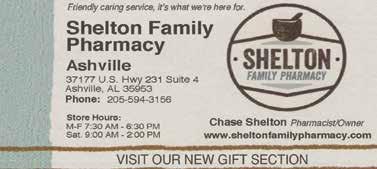



I heard a story recently I’d like to share with you. This isn’t a fable or folktale. This is a true story … a tale of two lives and how love always knows the way home.
He was rescued off the interstate one night in Rising Fawn, Ga., by an angel with a Louisiana accent. Dirty, malnourished and scared, he was brought to Alabama and given a new home and a new name – “Bear.” But dogs, especially those that roam, often have their own way of finding home and finding their way to the folks that really need them.
Several miles away from Bear’s new home, Lewis and John were outside their home planting a tree in memory of their beloved dog, Cliff, the day they first met Bear. Like a mirage of their former friend, also a Great Pyrenees, Bear appeared at the tree line and wandered up to rest atop the grave of the ghost that seemed to call him there.

Three miles he would roam. Nearly every day. Each day to arrive back at the same location and find rest near the remains of a friend he never knew. He lives there now. Bear found his home. He chose Lewis and John. It was obvious Bear was where he belonged. Whether it was canine intuition or divine providence that called him there, it begs the question … Does love transcend?
If we love something enough, do you think it can return to us? Like an echo to our heart’s call … It’s a well-known fact that all dogs go to heaven. So, it should go without saying, that they are sent from heaven, too. To fill a void … To help us mend ourselves … Or just to love us unconditionally … without motive or selfish gain … the way only a dog can.
(*A special thanks to Raetta Young (the Louisiana angel) & Lewis Windham & John Bluiett for helping me tell Bear’s story.)
- Mackenzie Free -
Wife, mother, photographer & current resident of the unassumingly magical town of Steele, Alabama


